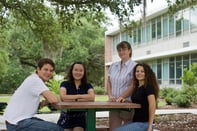Published on
Understanding the Academic Needs of Adults

Click here to read key takeaways
1. Why is the topic of adult satisfaction in higher education so underexplored?
It’s a variety of reasons and one of the biggest reasons is time. The influx of adult students in higher education is relatively new, especially when you’re looking at research. It was just in the last decade where adults really started coming back to higher [education] in the numbers we’ve been seeing. There was really nothing to study before that and this type of research, my research, is really just beginning. This type of research takes time. It takes a couple of years to even just do the research and by the time you take a look at everything and put it all together — it just doesn’t happen overnight.
The other piece of that, too, is previously adults were just somewhat integrated into face-to-face classes and so there wasn’t as much of an approach. There’s a lot of research on adult learning theory and adults in the classroom. What I’m looking at is, with the advent of the growth of online education, how adults are responding and the use of andragogy in an online environment. That’s the new piece of it.
2. What have you found to be factors that greatly increase adult student satisfaction in online programming?
It follows the trends you see in adult learning in a face-to-face or traditional environment. … I’ve used the andragogical conceptual framework and the things [Malcolm] Knowles has been talking about since 1984 are things that are as applicable in online education as well. Those are the five things like self-concept, experience, readiness to learn, orientation to learning and motivation to learn.
The biggest factor I found in my research so far is that adults really look at learning as a holistic experience and that means they bring all parts of their lives into the learning process. They’re not just there to check off a box; it’s not a means to an end for them.
Now, what motivates them to come back to school is certainly the degree, or lifestyle changes, or [a] new job, or a promotion in the workforce. Once they’re in school, their orientation to learning and their readiness to learn is all very integrated and it touches all aspects of their lives.
That’s really one of the biggest things this research is really beginning to push forward and that we’re seeing quite a bit of in talking with the students and talking about what faculty experiences are in these online classes that are targeted toward adults.
3. Conversely, what are some of the factors that cause adult students to become disengaged from their online courses?
That was actually one of the most interesting pieces I learned … is that adults really don’t like change; they don’t like surprises in the classroom. They like having flexibility, having instructors that understand there are a lot of life responsibilities they see at this point in their life that perhaps the traditional 18-year-old doesn’t have (that’s things like caring for children, working full time, caring for aging parents).
If I take each of those one by one: when I talk about change or surprise, adult students want to see the syllabus completed right at front. They want to know everything that’s going to be due and what they’re going to be working on for the entire semester. Once that syllabus is put in place, they don’t want any changes to it, not even if it means there is one less paper to do.
Adults will fit in their education in the time they have. So, if they know a paper is due in three weeks but they also know they’re going to be out of town that week for work, they will do that paper three weeks early. So then, when it comes time and all of a sudden, the instructor says, “We’re not going to have time for this so I’m dropping that paper.” Well, they put the work in.
They want to know what they’re in for. They plan out their entire semester for all of their courses around their life and they want to be able to hand in papers early. They want an instructor who will understand when an adult will call them or email them and say, “Work just called and I’m going to be out of town and I’m not going to be able to log in because I don’t have Wi-Fi. But, I will make up all that work, or I will do it early if you tell me what it is.” They don’t want the learning outcomes to be flexible. They don’t want to not do everything that’s expected, but they do want a certain amount of flexibility of when that work can be done.
4. Do these positive and negative factors typically line up with the responses of traditional-aged students?
No, they don’t at all.
Traditional-aged students are much better with change or last-minute surprises or going wherever an instructor takes them. If there are changes to the syllabus, it’s fine. They don’t get the entire syllabus right up front. They’re much more comfortable with that. And I think part of that is the big difference in their motivation to learn. … The motivation to learn is not as holistic for our traditional 18-year-old [as it is for adults]. Often times what they are doing is they are checking off a box. They need to do this class because it’s part of their degree requirement. And they don’t necessarily integrate that into their lives and they will do what they need to do to get the grade they want. [However], what we see is that the adult wants to gain as much from the learning process as they can.
5. Based on your research, what kinds of strategies and programs should institutions put into place to better serve their adult student populations?
It’s important that institutions work with their faculty and instructors so they understand the difference between a pedagogical model and an andragogical model, that these faculty are provided some training or orientation to adult students — to how adults might experience the learning process differently, what would engage them more in their courses — and apply it to their online populations.
The difficulty is … unique in that the online environment — where it was used quite extensively to bring the adult students back to campus, or at least virtually back to campus … — now [serves] traditional-aged students. We’re coming into a digital age and into digital learners. Students of all ages really want online learning. And so what we’re finding is that it’s not just enough to know that there’s a difference between adults and traditional-aged students, but we’re going to have to look at strategies on how we teach an integrated population.
That actually is going to be one of the biggest challenges for online programming in the next several years.
6. Is there anything you’d like to add about the importance of better understanding what adults are looking for from their online educational opportunities and, beyond that, how institutions can act on this information to improve their programming?
Recognizing that there is a difference; it’s not something that a lot of faculty necessarily will get behind or understand and it’s the basis of a lot of discussion and dialogue on our campus, and I’m sure on campuses across the nation. Not everyone believes there is a difference or that these aren’t … anything more than good teaching practices. While I agree that, for the most part, they are good teaching practices, what I believe and what the research is really beginning to show is that these are things that are very necessary for adults to become engaged and to do well in these courses. The conceptual framework and the adult learning theory behind it show that adults approach education differently. They approach learning differently.
Knowing that some of these things have to happen to keep your students engaged is an important factor to not only just keeping the students in the courses but [encouraging] the students to continue through the entire program and graduate at the end, which I think is what we all strive to have.
Adults are going to continue to come back to school. We don’t see much slowing down of the growth in the adult education market. Although there was a little blip this past year, I believe — especially because of online and where technology is going in education — [it] will continue to increase the access and the convenience and the flexibility for education of these adults so they don’t have to give up much of their life to be able to continue with their education.
Knowing that if you want a successful adult program or if you want the adults in your program to be successful, you’re going to have to have faculty who understand these differences; I really believe this is an important concept and that the research is holding that up very well.
– – – –
Key Takeaways
- Adult students have different motivations and needs from traditional-aged students.
- While programs should be designed with a degree of flexibility, it is critical not to offer too many surprises for adult students.
- Educators must recognize the need to design their programming with andragogy, not pedagogy, in mind.
Author Perspective: Administrator



